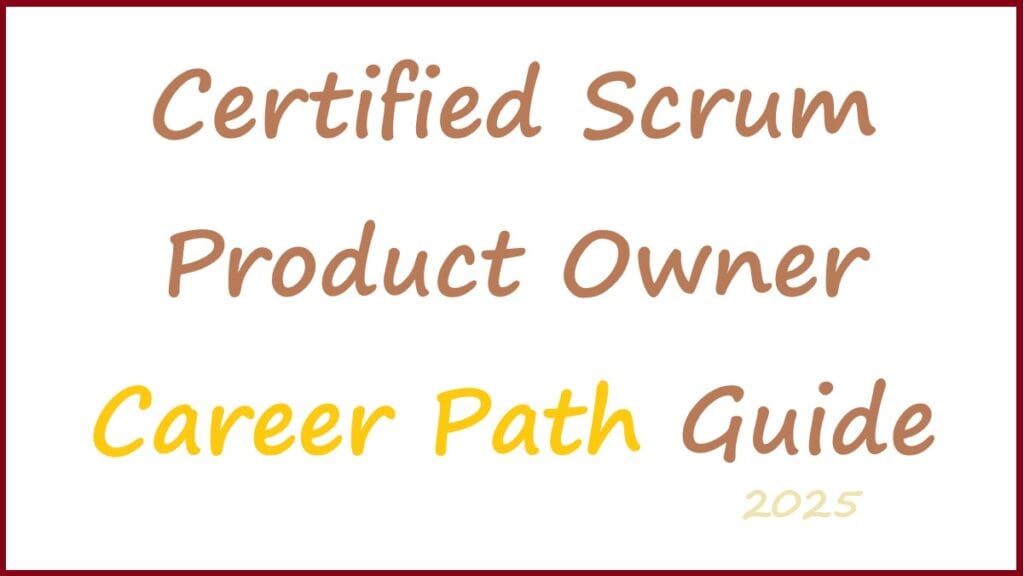Being a Certified Scrum Product Owner probably sets one up as a game changer in the contemporary technology-communicated job market. The increased interest towards agile frameworks has brought about the need to have professionals who would effectively blend the technical into the complex business goals. The given roadmap provides an answer to the question how to be successful in this sphere of interest.
Career Skill Path Certified Scrum Product Owner

What does the Certified scrum product owner do?
Core Responsibilities and Impact
Visualise this scenario: Stakeholders are quantifying and measuring everything with business KPIs while developers are “speaking in code” trying to communicate the product’s functionalities. Someone needs to bridge both of these worlds. That is when the Product Owner comes in. This position goes far beyond simply balancing a checklist, showing up for daily standups and Scrum rituals. Product Owners become the heartbeat of product development, translating customer dreams into features developers can actually build.
The real magic happens when Product Owners shape product strategy. They decide which features see the light of day and which ones get shelved. Every prioritisation decision impacts revenue, user satisfaction, and team morale. Months of development labor could be utterly squandered if the strategy contains just one erroneous decision. But do you get it right? At that time, commodities shift from being ordinary to being amazing.
Industry Demand and Opportunities
An fascinating tale is provided by the facts. Over the previous two years, organizations searching for talented Product Owners have doubled their job ads. Everyone wants someone who is adept in both business and technology, whether they are Silicon Valley startups or old institutions going digital.
Why is this demand there? Easy. Businesses have finally understood that it is a waste of time and money to throw developers at difficulties without clear instructions. Successful projects are 40% more likely to be completed by teams with certified Product Owners than by those without. Executives are evaluating their recruiting tactics based simply on that statistic.
CSPO Certification Process Explained
Training Requirements and Duration
The certification procedure starts with a two-day thorough training delivered by qualified Scrum Trainers. Endless PowerPoint presentations and tedious lectures are not a problem for you. Learning by doing is the major purpose of these workshops, which involve handling exercises, studying real-world circumstances, and role-playing sufficiently for each participant to feel comfortable giving tough presentations. Topics of interest are covered, ranging from crafting a compelling product vision to courteously treating stakeholders who feel their needs should always come first. Participants improve abilities in crafting user stories that developers will not reject, efficiently handling backlog grooming, and respectfully denying requests. Most notably, there isn’t a stressful final test. Practical skills continue to be stressed over memory.
Exam Format and Success Tips
Even though the CSPO certification does not involve a typical test, preparation is still vital. Before training commences, intelligent applicants acquaint themselves with the foundations of Scrum. They receive a head start by reading the Scrum Guide from beginning to end, knowing agile ideas, and becoming acquainted with common jargon.
Learning doesn’t end after certification. Scrum Education Units must be obtained through conferences, workshops, and community service in order to retain credentials. Product owners are kept up to speed on changing methods and new trends by this demand for continual education.
Essential Skills for Every Certified Scrum Product Owner
Technical vs Soft Skills Balance
Technical experience is vital; knowing how development processes work, being at comfortable using project management software, and having a basic understanding of analytics are all advantageous. However, the following differentiates exceptional product owners from average ones: great interpersonal talents.
The ability to communicate becomes a superpower. Product owners convey business needs to developers and simplify technical jargon for executives. They arbitrate disagreements across departments with different interests, conduct hard talks, and somehow manage to keep everyone focused on the same objectives. It requires a lot of talent to influence (lead) without authority; it demands patience, trust, and influence based on trust rather than title power.
Career Paths After Becoming Certified
Immediate Opportunities and Roles
Numerous new chances become accessible with a certification. Some people rise from employment as project managers or business analysts, while others are engaged as product owners right away. Professionals with the CSPO Certification in Pune are in great demand in Pune as there are various job vacancies for them before they have finished their training.
Career progress typically comes in phases. To grasp the principles and acquire confidence in their work, junior product owners begin by monitoring particular features or smaller products. After 18 to 24 months, a large number of them graduate to Senior Product Owner, where they handle sophisticated products or many projects from diverse teams. Product Owner skills’ versatility helps rapid migrations between industries. E-commerce experience, for instance, will be advantageous in the banking or healthcare IT industries.
Getting Started as a Certified Scrum Product Owner
Preparation Resources and Timeline
It takes roughly three months of strategic planning to be effective. Foundational learning takes occur during the first month, which involves reading the Scrum Guide, examining agile resources, and building links with other agile groups. The focus of the second month is on certification training and the fast implementation of suggestions. Networking, job hunting, and expanding knowledge via practice are the key subjects of the previous month.
Attending local Product Owner events, which give great networking opportunities and real-world insights, is another vital resource in addition to books or guidelines. Local online communities publish job opportunities, give support, and reply to queries. Rather than formal training, many seasoned Product Owners credit their professional development to the contacts they formed in these communities. Every individual who desires to pursue this route must understand that it includes a tremendous deal of effort, stress, and the capacity to be at comfortable with uncertainty. However, the financial and professional rewards may improve a person’s career if they are prepared to engage in these obstacles.